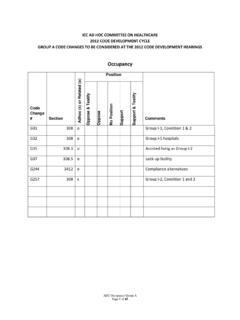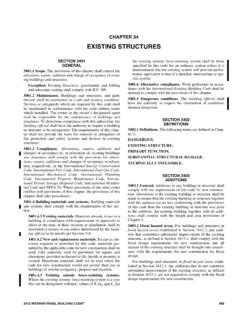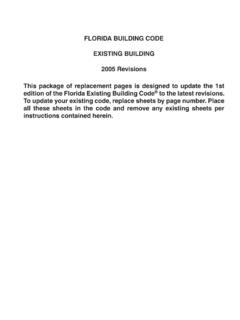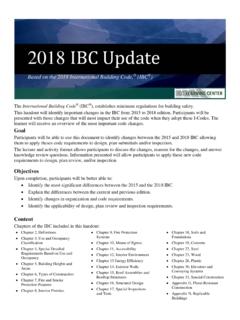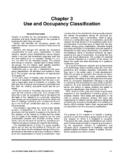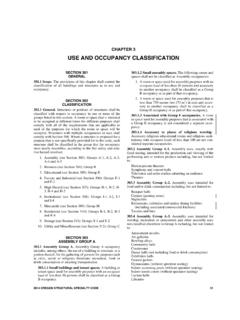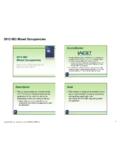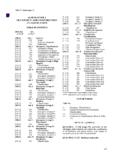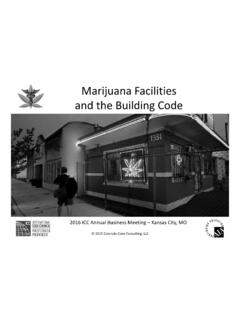Transcription of OCCUPANCY CLASSIFICATION AND USE - iccsafe.org
1 PLEASE NOTE: These are clean sheet provisions. If pursued, a delete in its entirety and replace format should be used. The proposed format and verbiage is intended as a point of departure for study group discussion. CHAPTER 3 OCCUPANCY CLASSIFICATION AND USE SECTION 301 SCOPE General. The provisions of this chapter shall control the CLASSIFICATION of all buildings as to practical purpose. Different classifications of OCCUPANCY , use and function represent varying levels of hazard and risk to building occupants. SECTION 302 OCCUPANCY CLASSIFICATION General. OCCUPANCY CLASSIFICATION is the formal designation of the primary purpose of the building, structure or portion thereof. Buildings and structures shall be classified into one or more of the OCCUPANCY groups listed in this section based on the nature of the hazards and risks to building occupants generally associated with the intended purpose of the building or structure.
2 An area, room or space that is intended to be occupied at different times for different purposes shall comply with all applicable requirements associated with such potential multi-function. Buildings containing multiple OCCUPANCY groups shall comply with Section 508. Buildings containing incidental uses shall comply with Section 509. Where a building or structure is proposed for a purpose that is not specifically listed in this section, such building or structure shall be assigned an OCCUPANCY CLASSIFICATION of the OCCUPANCY group that it most nearly resembles based on those hazard and risk factors listed in this section. SECTION 303 USE DESIGNATION General. OCCUPANCY groups contain subordinate uses having somewhat similar hazards and risks to building occupants. Uses include, but are not limited to, those functional designations listed within the OCCUPANCY group descriptions in this section. Certain uses require specific limitations and controls in accordance with the provisions of Chapter 4 and elsewhere in this code.
3 SECTION 304 FUNCTION DESIGNATION General. The determination of occupant loads for the purposes of means of egress design is based on the function of the area, room or space under consideration as listed in Table The assigned function of the space establishes an occupant density (occupant load factor) based on typical usage. SECTION 305 OCCUPANCY GROUP A General. Buildings or portions thereof classified as Group A occupancies are intended for public or commercial assembly purposes. The use of such buildings includes, but is not limited to, the gathering together of persons for purposes such as civic, social or religious functions; recreation, food or drink consumption or awaiting transportation. Hazard or risk factors typically associated with Group A occupancies include: Occupant familiarity: Low Fuel load: Low Diminished physical or mental capacity: Low Sleeping: No - .4. Group A-1 OCCUPANCY . Assembly SECTION 306 OCCUPANCY GROUP B General.
4 Buildings or portions thereof classified as Group B occupancies are intended for general business purposes. The use of such buildings includes, but is not limited to, the gathering together of persons for purposes such as office, professional or service-type transactions, including storage of records and accounts. Hazard or risk factors typically associated with Group B occupancies include: Occupant familiarity: Moderate to high Fuel load: Ordinary or moderate Diminished physical or mental capacity: Low Sleeping: No (The following Chapter 4 provisions are reorganized to follow the purpose hierarchy established in Chapter 3 as well as being reworded to be more consistent between the various Chapter 4 sections. A legislative format is recommended if this proposal is pursued,) CHAPTER 4 DETAILED REQUIREMENTS BASED ON OCCUPANCY CLASSIFICATION , USE AND BUILDING CONFIGURATION SECTION 401 SCOPE General. In addition to the general OCCUPANCY design and construction requirements specified elsewhere in this code, the detailed provisions of this chapter shall apply to the OCCUPANCY groups, uses and building configurations listed herein.
5 SECTION 402 GROUP H OCCUPANCIES (COMBINE WITH HAZARDOUS MATERIALS SECTION 414) (Current Sections 414 and 415 can be easily combined so as to make Group H requirements more user friendly General. Group H occupancies shall comply with the provisions of Sections through and other applicable provisions of this code. SECTION 403 GROUP I-1, R-1, R-2 AND R-3 OCCUPANCIES General. Group I-1, R-1, R-2 and R-3 occupancies shall comply with the provisions of Sections through and other applicable provisions of this code. SECTION 404 GROUP I-2 OCCUPANCIES General. Group I-2 occupancies shall comply with the provisions of Sections through and other applicable provisions of this code. SECTION 405 GROUP I-3 OCCUPANCIES General. Group I-3 occupancies shall comply with the provisions of Sections through and other applicable provisions of this code. (Delete definition references or add where missing in subsequent sections.))
6 SECTION 406 MOTOR VEHICLE RELATED OCCUPANCIES General. Motor vehicle related occupancies shall comply with the applicable provisions of Sections through and other applicable provisions of this code. SECTION 407 AIRCRAFT RELATED OCCUPANCIES General. Aircraft related occupancies shall comply with the applicable provisions of Sections through , other applicable provisions of this code and the International Fire Code. SECTION 408 MOTION PICTURE PROJECTION ROOM USES General. Rooms in which ribbon-type cellulose acetate or other safety film is utilized in conjunction with electric arc, xenon or other light-source projection equipment that develops hazardous gases, dust or radiation shall comply with the provisions of Sections through Where cellulose nitrate film is utilized or stored, such rooms shall comply with NFPA 40. SECTION 409 STAGES, PLATFORMS AND TECHNICAL PRODUCTION AREA USES General. All portions of buildings and structures that contain stages or platforms, as defined in Chapter 2, and similar appurtenances shall comply with the provisions of Sections through (The charging language contains no references to technical production areas although that term is contained in the section title.)
7 Also, delete current section definition references to be consistent with other sections in this chapter.) SECTION 410 SPECIAL AMUSEMENT USES General. Special amusement buildings having an occupant load of 50 or more shall comply with the applicable requirements for the appropriate Group A OCCUPANCY and the provisions of Sections through Amusement buildings having an occupant load of less than 50 shall comply with the applicable requirements for Group B OCCUPANCY and the provisions of Sections through (What is a special amusement building versus an amusement building as defined in Chapter 2? Please note that the second sentence currently does not contain the term special. ) SECTION 411 AMBULATORY CARE FACILITY USES General. Group B occupancies containing ambulatory care facility uses shall comply with the provisions of Sections through and other applicable provisions of this code. SECTION 412 COMBUSTIBLE STORAGE USES (RE-NAME HIGH-PILED STOCK OR RACK COMBUSTIBLE STORAGE USES) General.
8 High-piled stock or rack storage for the storage of combustible materials in any OCCUPANCY group shall comply with the provisions of Section and the International Fire Code. SECTION 413 APPLICATION OF FLAMMABLE FINISHES USES General. Areas used for the application of flammable finishes shall comply with the provisions of Sections through 413. Such construction and equipment shall also comply with the International Fire Code. SECTION 414 DRYING ROOM USES General. (Current charging language is very confusing and vague.) SECTION 415 ORGANIC COATINGS USES General. Areas used for the manufacturing of organic coatings shall comply with the provisions of Sections through (Section 418 currently contains no charging language. A general section should be created and the remaining subsections should be renumbered accordingly.) SECTION 416 HYDROGEN CUTOFF ROOM USES General. Where required by the International Fire Code, hydrogen cutoff rooms shall be designed and constructed in accordance with the provisions of Sections through SECTION 417 LIVE/WORK UNIT USES General.
9 Live/work units, as defined in Chapter 2, shall comply with the provisions of Sections through SECTION 418 HIGH-RISE BUILDINGS General. High-rise buildings, as defined in Chapter 2, shall comply with the provisions of Sections through Exception: SECTION 419 UNDERGROUND BUILDINGS General. The provisions of Sections through shall apply to building spaces having a floor level used for human OCCUPANCY more than 30 feet (9144 mm) below the finished floor of the lowest level of exit discharge. SECTION 420 COVERED MALL AND OPEN MALL BUILDINGS General. Covered or open mall buildings, as defined in Chapter 2, not exceeding three floor levels (stories?) at any point nor more than three stories above grade plane shall comply with the provisions of Sections through Except as specifically required by this section, covered and open mall buildings shall meet the applicable provisions of this code. Exceptions: SECTION 421 ATRIUMS General.
10 In other than Group H occupancies, and where permitted by Section , the provisions of Sections through shall apply to buildings or structures containing vertical openings defined as Atriums in Chapter 2. SECTION 422 STORM SHELTERS General. In addition to other applicable requirements in this code, storm shelters shall be constructed in accordance with ICC 500. SECTION 423 CHILDREN S PLAY STRUCTURES General. Children s play structures installed inside all occupancies covered by this code that exceed 10 feet (3048 mm) in height and 150 square feet (14 m2) in area shall comply with the provisions of Sections through
